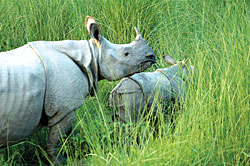|
|
All attention was on the constituent assembly elections on 10 April when the Bardiya National Park here in western Nepal staff left for polling duty at various voting centres.
Wildlife poachers seemed to have prepared well for the period of lax security at election time. They killed a rhino at Thakur Dwar on 3 April. Early next morning the national park officers found not only a dead rhino with the horn taken out, but also the body nearby of a soldier killed by the poachers.
The army says the soldier,who was off duty and going home, was killed by an assault rifle wielded by the poachers because he happened to be a witness. This is the first time that an SLR has been used by poachers in Bardiya, and the army suspects international poaching syndicates are getting more organised and getting guns left over from Nepal's conflict. Five rhinos have been killed in the park in the last six months.
From 1986 to 2002, over 83 rhinos were brought in from Chitwan National Park to Bardiya. But a rhino census last June showed that there were only 31 rhinos left in the park, and another count in February showed the number was down to 22. Last year four rhinos were killed just before Dasain, and three of them were found in the buffer zone surrounding the park.
Under the comprehensive peace agreement, the army is not allowed to patrol the buffer zone with arms, and conservationists say this is the reason why poaching has increased in the last few months. (See also: 'Parking the army', #391)
"The situation inside the national park is quite tight, but since we are not allowed to patrol with guns in the buffer zone, poaching has increased in the recent months," says Col Samir Singh at Bardiya.
Chief Warden of the park, Phadindra Kharel is concerned that if present trends persist and given the fluid political situation, rhinos may become extinct in Bardiya. He says that the park officers are not armed, and the army hasn't been able to stop poaching. "Even if you put an entire battalion in charge of the park, the situation will not change. We have to re-evaluate what the army, which carries modern weapons, are doing to protect the park," says Kharel.
It is clear that there is no coordination between the park authorities and the army that has been deployed to protect it. Worse, they seem busier pointing fingers at one another than in trying to solve the problem together. The poachers have simply taken advantage of the confusion.
During the war, Nepal Army security units inside the park were dismantled, and the park's anti-poaching intelligence network in the buffer zone broke down. But the conflict prevented free movement so poachers were scared. It was during the political transition of the past two years that more rhinos have been killed for their horns.
Apart from the three people arrested in Chisapani while trying to smuggle rhino horns across the border in September 2006, no one else has been caught. Between July 2006 and May 2008 the army may have arrested over 100 people with shotguns, but they were either for poaching deer, or illegally felling trees.
Warden Kharel is worried by poachers now using advanced weapons and wonders how these are getting inside the park.



